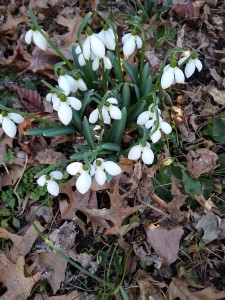 Winter is only one month old and even if the groundhog doesn’t see his shadow, it is going to be a long wait until spring. You can spend that time staying warm, perusing catalogs and tending the houseplants, but many of us miss being outside.
Winter is only one month old and even if the groundhog doesn’t see his shadow, it is going to be a long wait until spring. You can spend that time staying warm, perusing catalogs and tending the houseplants, but many of us miss being outside.
“Outside” is not always congenial, due to seasonal drama provided by temperature, wind, precipitation, or a combination of all three. I especially loathe the dreaded “wintery mix”, when precipitation pelts down in various forms, especially freezing rain. There are few things as unpleasant as having your exposed parts bombarded with icy needles of semi-frozen water.
Still, there are plenty of days when temperatures are bearable and skies are clear. Some of those days even come on weekends. I relish them. Daylight is also increasing at the rate of about one minute per day. Soon it will be possible to get out for at least short periods at the end of the work day. Even fifteen minutes can raise mood and produce positive results in the garden.
So what can you do when the ground is frozen and branches are bare?
You can start by taking stock. Walk around your garden and note things that you want to change. If your property is home to more than one bed, border, or “room”, treat each area as a separate garden. This sharpens focus and makes changes less overwhelming. When you look at those “gardens”, think about the placement of key elements, including hardscaping, trees, shrubs and perennial plants. .Trees are hard to move, but shrubs and plants can be rearranged. Early spring is a good time to do that, so it follows that winter is the ideal time to assess those changes. Take pictures to help you in the process. If you have pictures of your garden in other seasons, use them to help you remember which perennials pop up in various locations.
Hardscaping is easy to overlook during the growing season, but if your home ground features sagging fences, deteriorating walls, or walkways that have seen better days, decide what repairs you want or can afford. Now is a perfect time to reach out to contractors, get estimates and plan for those projects.
My back fence looks as if a large rabbit could knock it over with one swipe of a paw. With luck I’ll replace it before that happens.
If you abandoned fall clean-up for any reason, pick up the tasks now. The birds have gotten all they can from those desiccated seed heads of coneflowers or asters. A landscape of gray and brown sticks is uninspiring, so clean it up.
Prune flowering shrubs that bloom in summer and fall. If something that flowers in spring is wildly overgrown and unwieldy, prune it back. You will eliminate some, or possibly even all flowers for this spring, but you will end up with a shrub of manageable size. My flowering quince, once again overgrown and drowning in a tangle of sweet autumn clematis vines, is an ongoing challenge. This is partly because I am lazy and party because the quince is armed with hundreds of formidable thorns. Risking the pain and working on it now when it is leafless and the thorns are easier to spot will reduce its overall size and make it easier to manage in the future.
Probably the most pleasant job at this time of year is to look for the earliest signs of spring. If the ground is not covered with snow, look for the tips of daffodils, not to mention the blooms of heroic snowdrops, winter aconite and hellebores, especially Helleborus niger, the “Christmas rose”. It is amazing how such small plants can generate so much cheer. If you don’t grow any of those plants, consider investing in them during the growing season. By March, hellebores, in bud or in bloom, may be available in garden centers.
Some tasks may be specific to your particular garden. For example, I put all the pots of fall mums in a protected outdoor spot and leave them over the winter. Some will not survive, but the ones that make it through the cold months go into the garden when spring rolls around. I generally check on them periodically. I will also look in on and water the containerized plants that are spending the winter in my unheated garage. Most are dormant, but it pays to keep tabs.
And, of course, I inspect the groundhog holes. The one by my garage seems to be bigger than ever this year. Now is the time to fill it with used cat litter to discourage the plant-devouring  pests come spring. Thank goodness the cat is very obliging.
pests come spring. Thank goodness the cat is very obliging.
